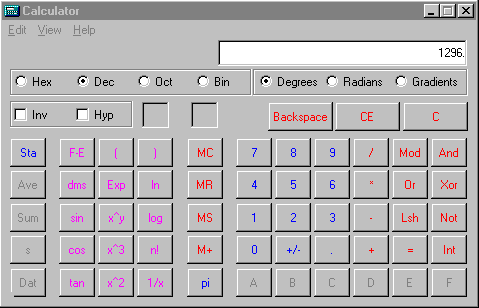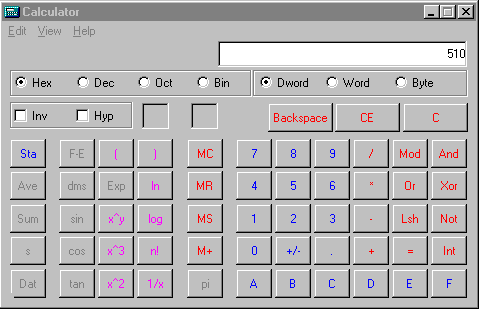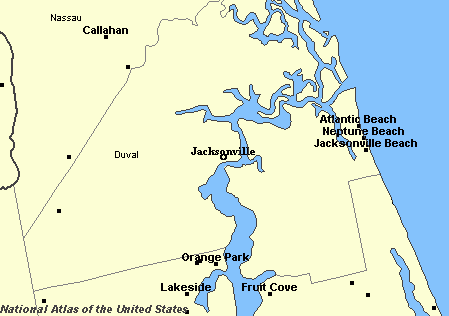| This article first appeared in the July 2003 issue of Monitoring Times. |
Information about talkgroups in a trunked radio system is often available in different forms. Lists posted on the Internet and released by public safety agencies may have different formats or report numbers in unexpected ways.
Rapides Parish, Louisiana
Dear Dan,I live in Rapides Parish, Louisiana. The parish was on a Type I system, but is in the process of switching to a Motorola Type II system. I was able to obtain some talkgroup Id information for this system. The talkgroup Ids I have start at 800001 and go to 801117. All talkgroup Ids that I have seen for other areas only go to 5 digits and are usually even numbers. When I put these numbers into a scanner, it says invalid ID. Do these numbers need to be converted and can they be converted by some formula to an ID that the scanner will monitor.
Thank you in advance,
Ron
Ron, what you probably have is a list of "Console" Identifiers (Ids), which are the numbers that appear on the operator's console in the dispatch center when a radio is using the system. As you've seen, each of these console numbers has a prefix of "8." The rest of the number is either a talkgroup or radio identifier. It does not include the four status bits that are transmitted over the air and displayed by your scanner as the final digit.
Talkgroup identifiers are usually shown as even numbers because they are reported with all status bits off. In a Motorola Type II system the last four bits ("binary digits") represent the status of the radio.
If the left-most of those four bits is set (has a value of '1' rather than '0') it means the transmission is encrypted. The three right-most status bits indicate if the message is an emergency and whether the talkgroup is interconnected in some way. More information about Motorola Type II trunking can be found in the April 2001 Tracking the Trunks column.
A status of all zeroes indicates a normal transmission, so a regular message has status bits of FONT FACE="Courier New">0000 (0 in decimal). Since the status bits are the least significant part of the talkgroup number, they determine whether the number is odd or even. Since all four bits are normally set to zero, lists of decimal talkgroup numbers show differences of 16 or some multiple of 16. Some lists drop the last four bits altogether.
So, to convert each of those console identifiers, remove the "8" prefix and multiply the remaining number by 16. What you have at that point is the decimal representation of the talkgroup number that most scanners and software programs recognize. For example, the console identifier 800050 would be 50 times 16, or 800 decimal.
If you need that number in hexadecimal format, the easiest way to change it is by using a calculator with a conversion capability. Microsoft Windows has this capability in their Calculator accessory, if you choose the "Scientific" mode under the View selections. Click on the "Dec" radio button and enter your decimal number. Then click on the "Hex" radio button and the hexadecimal value will be displayed.


Below is a table that with some examples that should help you perform the conversions.
Console Identifier Decimal Hex
800001 16 0010
800002 32 0020
800003 48 0030
800004 64 0040
800005 80 0050
... ... ...
800010 160 00A0
800011 176 00B0
... ... ...
800050 800 0320
800051 816 0330
800100 1600 0640
800101 1616 0650
... ... ...
800500 8000 1F40
800501 8016 1F50
... ... ...
801000 16000 3E80
801001 16016 3E90
... ... ...
801117 17872 45D0
The frequencies I have listed for Rapides Parish are 855.7125, 855.9625, 856.7125, 856.9375, 857.7125, 857.9375, 858.2625, 858.7125, 858.9375, 859.2625, 859.7125, 859.9375, 860.2625, 860.7125 and 860.9375 MHz. I don't have any talkgroup information, so Ron, please send along your list of talkgroups!
Jacksonville, Florida
The police in Jacksonville, Florida, have begun encrypting the digital radio transmissions on their trunked radio system. Under the cover of homeland security, the decision was made to use the optional encryption capability in their system. In defending their decision, the department also indicated that criminals use scanners to keep track of police patrols.
It is not clear which police transmissions, if any, will remain "in the clear" (unencrypted). It is also undecided whether the news media will be given access to some of the less sensitive police talkgroups. Fire and rescue transmissions, as well as public works and other municipal agencies, are expected to remain in the clear.
The decision of the department to encrypt has raised the normal concerns about visibility and accountability within the police department, which has been troubled by corruption and excessive force complaints in the past.

The Jacksonville trunked radio system is a ten-site Motorola ASTRO system used by police, fire, emergency medical personnel as well as city and Duval County employees. This $41 million system has nearly 10,000 radios, half of which are used by police and other law enforcement departments.
Frequencies used on the system are 854.9625, 855.2125, 855.4875, 855.9626, 855.9875, 856.2125, 856.2625, 856.4625, 856.7125, 856.7375, 856.9375, 856.9625, 856.9875, 857.2375, 857.4625, 857.7125, 857.9375, 857.9625, 858.7125, 858.9625, 859.4625, 859.7125, 859.9375, 859.9625, 859.9875, 860.4625, 860.7125 and 860.9375 MHz.
Talkgroups:
Jacksonville Fire/Rescue (Digital)
17360 43D Main
17392 43F Fire Dispatch
17424 441 Emergency Medical Service 1
Jacksonville Sheriff's Office (Digital, Encrypted)
18320 479 Zone 1
18352 47B Zone 2
18384 47D Zone 3
18416 47F Zone 4
18448 481 Zone 5
18480 483 Zone 6
Analog talkgroups
16 001 Public Works
48 003 Public Works
336 015 Parking Enforcement
432 01B Parks Department
688 02B Street Department
944 03B Parks Department
1104 045 Jacksonville Fire Rescue
1136 047 Jacksonville Fire Rescue Tactical
1168 049 Jacksonville Fire Rescue Tactical (simulcast 460.525 MHz)
1264 04F Fleetwide
1296 051 Emergency Operations Center 1
1328 053 Emergency Operations Center 2
1360 055 Emergency Operations Center 3
Nearby Jacksonville Beach operates a Motorola Type II system on 856.7625, 857.7625, 858.7625, 859.7625 and 860.7625 MHz. Some talkgroups:
57360 Fire Dispatch
57392 Fireground
57968 Lifeguard Dispatch
58000 Lifeguard Supervisors
58768 Police Dispatch
58800 Police Tactical
Anne Arundel County, Maryland
Anne Arundel County, Maryland will be updating their radio system to the tune of $12.7 million over the next year. The county is working to reduce or eliminate cellular tower interference at more than 60 locations, where officers have been unable to reliably communicate with their dispatch center. An additional 16 radio frequencies, to be added as part of the upgrade, should help this situation. Improvements will also include the ability to handle both analog and digital radios.
The County currently operates a Motorola Type II analog system on the following frequencies: 856.3625, 856.3875, 856.4125, 857.3625, 857.3875, 857.4125, 858.3625, 858.3875, 858.4125, 859.3625, 859.3875, 859.4125, 860.3625, 860.3875 and 860.4125 MHz.
Talkgroups:
57360 E01 Emergency Medical Service Dispatch
57392 E03 Emergency Medical Service
57424 E05 Emergency Medical Service
57488 E09 Fireground Operations
57520 E0B Fireground Operations
57552 E0D Command
57584 E0F Mutual Aid (simulcast on 154.280 MHz)
57808 E1D Fire to Police
Annapolis, Maryland
Meanwhile in the state capitol of Annapolis, Maryland, a new $330,000 mobile data system from Motorola has come on-line. Twenty patrol cars are equipped with the Mobile Workstation 520 (MW520), a computer system with a radio-modem and flat-panel color touch screen running the Windows operating system. The unit will be able to display text as well as photographs and fingerprints from state and Federal databases.
To the north of Annapolis, in Pennsylvania, the state police there are deploying MW520 wireless workstations in more than 600 vehicles after a successful test in the southern part of the state.
Marin County, California
In April of this year Marin County voted to begin operation of their $21 million trunked radio system without a resolution on the placement of a repeater site in Tiburon, in the southern part of the county. The system was originally scheduled to go on-line more than a year ago, but local objections to the construction of some of the dozen or so sites in Marin and Sonoma counties have delayed completion. The towns of Belvedere, Mill Valley and Tiburon will lack effective coverage until the repeater site issue can be resolved.
Marin County, just north of San Francisco, currently operates a Motorola ASTRO mixed analog and digital system in the UHF (Ultra High Frequency) band with a base of 482 MHz, spacing of 12.5 MHz and an offset of 380. The system frequencies are 482.3500, 482.6250, 482.6500, 482.7875, 482.9375, 483.0250, 483.1250, 488.7000 and 489.0750 MHz.
Hamilton County, Ohio
Hamilton County, in the southwest corner of Ohio, is planning on having their $35 million radio system up and running by fall. It will replace a 25-year-old UHF system and a VHF fire network. The county has purchased nearly 2,000 radios for the 40 communities and agencies that will join the system, although some local police departments are objecting to the user fees charged by the county to construction and operating costs. Meanwhile the city of Cincinnati is expected to fully complete their new $24 million system in about a year and half, at which point users from both systems will be able to talk to each other directly.
The Hamilton County radio network is a Motorola ASTRO digital system, but some reports indicate analog traffic is also in use. There are a half-dozen sites operating on the following frequencies: 866.1625, 866.2500, 866.2750, 866.3000, 866.6500, 866.7875, 867.2375, 867.2375, 867.2375, 867.5375, 867.7375, 867.7625, 867.8125, 867.8500, 868.1250, 868.2625, 868.3625, 868.5625 and 868.9500 MHz.
Some talkgroups on this system include:
48 003 Engineering
4816 12D Water Department
4848 12F Sewer Department
6512 197 Building Inspectors
9616 259 Fire Mutual Aid
33616 835 County Fire Dispatch (East)
33648 837 County Fire Dispatch (West)
33776 83F County Fireground 1
33808 841 County Fireground 2
33840 843 County Fireground 3
33872 845 County Fireground 4
33904 847 County Fireground 5
33936 849 County Fireground 6
33968 84B County Fireground 7
34000 84D County Fireground 8
35216 899 County Sheriff Dispatch (East)
35248 89B County Sheriff Dispatch (West)
35280 89D County Sheriff Dispatch (Central)
35536 8AD County Sheriff Dispatch Car-to-car
The new Cincinnati system is a Motorola ASTRO digital system (with a 3600-baud control channel) using the following frequencies: 866.1125, 866.1875, 866.2125, 866.4625, 866.5625, 866.5875, 866.6875, 866.8125, 866.8375, 867.0875, 867.1125, 867.2625, 867.3125, 867.3375, 867.6125, 867.6375, 867.6625, 868.6375, 868.7875 and 868.8625 MHz. Detectives have been heard on talkgroup 12912 (hex 327).
Can anyone in the Hamilton County area give us a more up-to-date report on the activity on these two systems?
As a reminder, APCO Project 25 system frequencies and tower locations are available on my website at www.signalharbor.com. I welcome your questions, comments and corrections via my e-mail address, danveeneman@monitoringtimes.com. Until next month, happy monitoring!